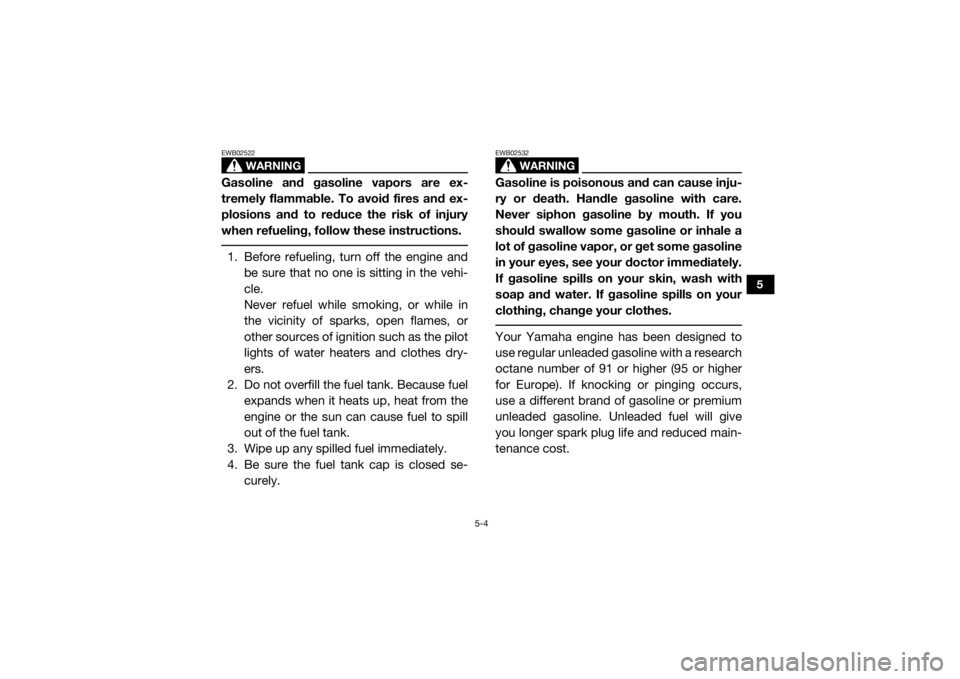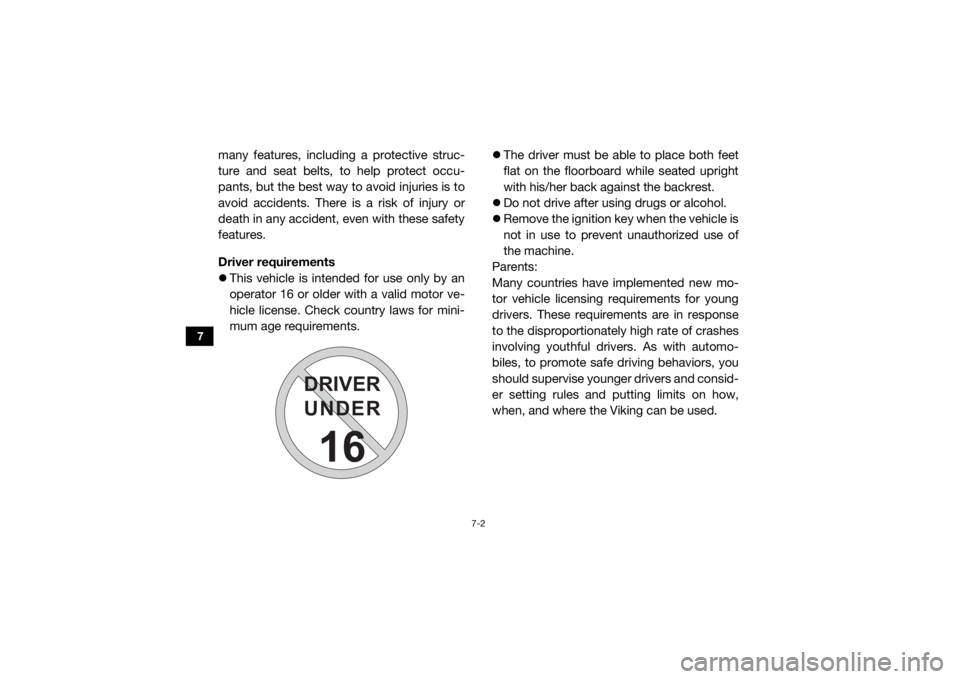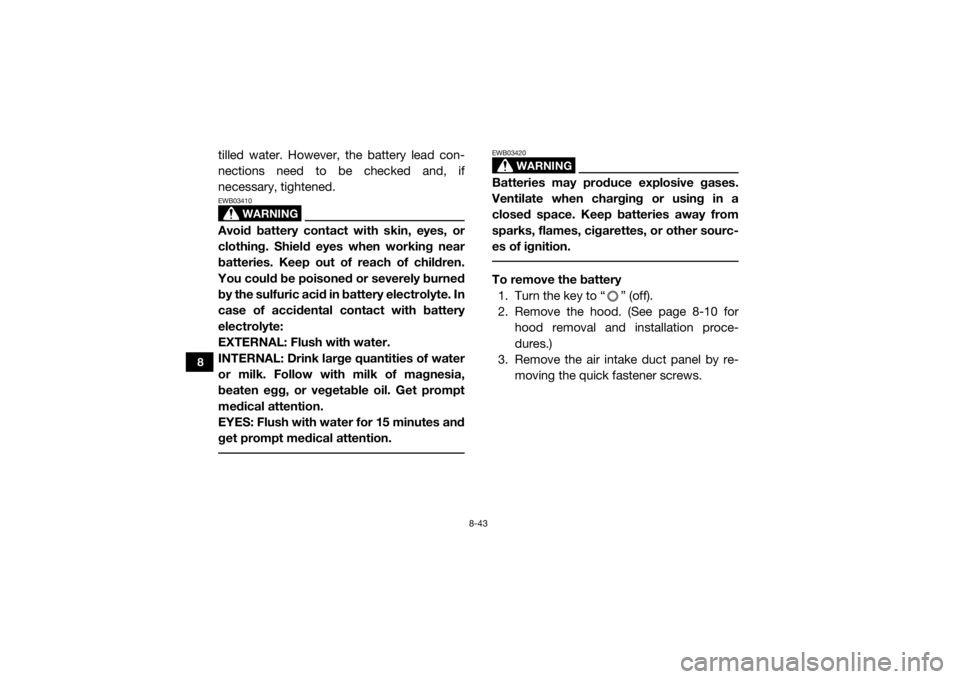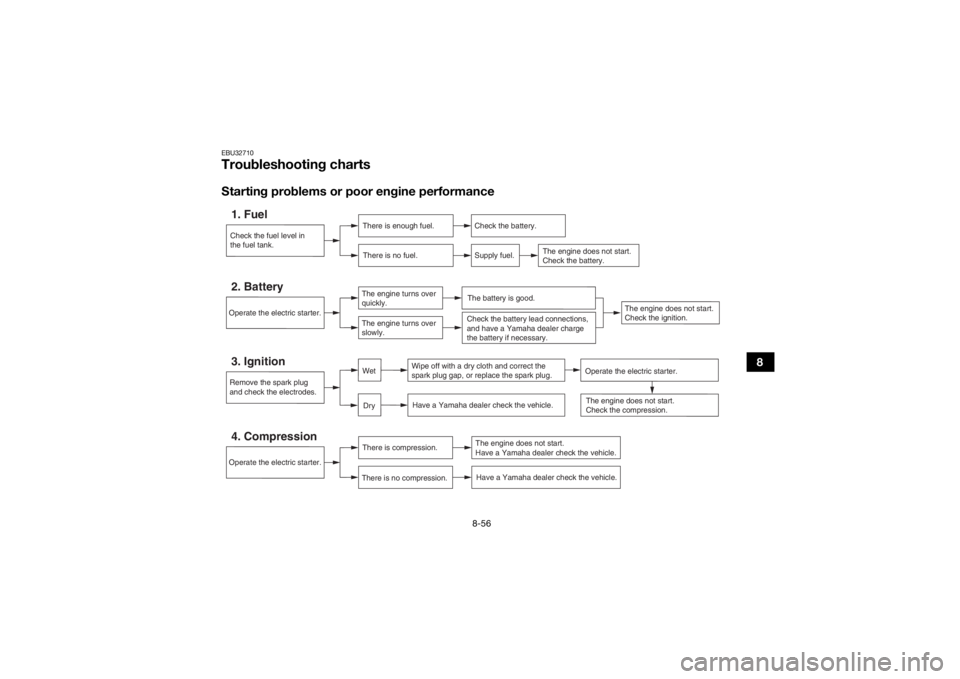Page 63 of 172

5-4
5
WARNING
EWB02522Gasoline and gasoline vapors are ex-
tremely flammable. To avoid fires and ex-
plosions and to reduce the risk of injury
when refueling, follow these instructions. 1. Before refueling, turn off the engine andbe sure that no one is sitting in the vehi-
cle.
Never refuel while smoking, or while in
the vicinity of sparks, open flames, or
other sources of ignition such as the pilot
lights of water heaters and clothes dry-
ers.
2. Do not overfill the fuel tank. Because fuel expands when it heats up, heat from the
engine or the sun can cause fuel to spill
out of the fuel tank.
3. Wipe up any spilled fuel immediately.
4. Be sure the fuel tank cap is closed se-
curely.
WARNING
EWB02532Gasoline is poisonous and can cause inju-
ry or death. Handle gasoline with care.
Never siphon gasoline by mouth. If you
should swallow some gasoline or inhale a
lot of gasoline vapor, or get some gasoline
in your eyes, see your doctor immediately.
If gasoline spills on your skin, wash with
soap and water. If gasoline spills on your
clothing, change your clothes. Your Yamaha engine has been designed to
use regular unleaded gasoline with a research
octane number of 91 or higher (95 or higher
for Europe). If knocking or pinging occurs,
use a different brand of gasoline or premium
unleaded gasoline. Unleaded fuel will give
you longer spark plug life and reduced main-
tenance cost.
UB427BE0.book Page 4 Friday, February 5, 2016 2:14 PM
Page 80 of 172

7-2
7
many features, including a protective struc-
ture and seat belts, to help protect occu-
pants, but the best way to avoid injuries is to
avoid accidents. There is a risk of injury or
death in any accident, even with these safety
features.
Driver requirements
This vehicle is intended for use only by an
operator 16 or older with a valid motor ve-
hicle license. Check country laws for mini-
mum age requirements.
The driver must be able to place both feet
flat on the floorboard while seated upright
with his/her back against the backrest.
Do not drive after using drugs or alcohol.
Remove the ignition key when the vehicle is
not in use to prevent unauthorized use of
the machine.
Parents:
Many countries have implemented new mo-
tor vehicle licensing requirements for young
drivers. These requirements are in response
to the disproportionately high rate of crashes
involving youthful drivers. As with automo-
biles, to promote safe driving behaviors, you
should supervise younger drivers and consid-
er setting rules and putting limits on how,
when, and where the Viking can be used.
DRIVER
UNDER
16
UB427BE0.book Page 2 Friday, February 5, 2016 2:14 PM
Page 142 of 172

8-43
8
tilled water. However, the battery lead con-
nections need to be checked and, if
necessary, tightened.
WARNING
EWB03410Avoid battery contact with skin, eyes, or
clothing. Shield eyes when working near
batteries. Keep out of reach of children.
You could be poisoned or severely burned
by the sulfuric acid in battery electrolyte. In
case of accidental contact with battery
electrolyte:
EXTERNAL: Flush with water.
INTERNAL: Drink large quantities of water
or milk. Follow with milk of magnesia,
beaten egg, or vegetable oil. Get prompt
medical attention.
EYES: Flush with water for 15 minutes and
get prompt medical attention.
WARNING
EWB03420Batteries may produce explosive gases.
Ventilate when charging or using in a
closed space. Keep batteries away from
sparks, flames, cigarettes, or other sourc-
es of ignition. To remove the battery
1. Turn the key to “ ” (off).
2. Remove the hood. (See page 8-10 for hood removal and installation proce-
dures.)
3. Remove the air intake duct panel by re-
moving the quick fastener screws.
UB427BE0.book Page 43 Friday, February 5, 2016 2:14 PM
Page 147 of 172
8-48
8
If a fuse is blown, replace it as follows.1. Turn the key to “ ” (off) and turn off the
electrical circuit in question.
1. Fuse box
2. Main fuse
3. EPS fuse
4. Fuel injection system fuse
5. Fuel injection system spare fuse
1 3
2
4
5
1. Backup fuse “BACK UP” (for clock)
2. Ignition fuse “IGNITION”
3. Four-wheel-drive motor fuse “DIFF”
4. Auxiliary DC jack fuse “TERMINAL”
5. Signaling system fuse “SIGNAL”
6. Headlight fuse “HEAD”
7. Spare fuse
8. Radiator fan motor fuse “FAN”
1
2
3
4
5
6
8
7
7
UB427BE0.book Page 48 Friday, February 5, 2016 2:14 PM
Page 148 of 172
8-49
8
NOTICEECB00641To prevent accidental short-circuiting,
turn off the main switch when checking or
replacing a fuse. 2. Remove the hood. (See page 8-10 forhood removal and installation proce-
dures.)
3. Remove the blown fuse, and then install a new fuse of the specified amperage.
WARNING! Always use a fuse of the specified amperage. Never use any
material in place of the proper fuse.
Using an improper fuse can cause
damage to the electrical system and
may lead to a fire.
[EWB03440]
Specified fuses: Main fuse:40.0 A
Fuel injection system fuse: 10.0 A
Headlight fuse: 15.0 A
Ignition fuse: 10.0 A
Auxiliary DC jack fuse: 10.0 A
Signaling system fuse: 10.0 A
Four-wheel-drive motor fuse: 10.0 A
Radiator fan motor fuse: 25.0 A
Backup fuse: 10.0 A
EPS fuse: 40.0 A
UB427BE0.book Page 49 Friday, February 5, 2016 2:14 PM
Page 153 of 172

8-54
8
2. Remove the tail/brake light bulb holder(together with the bulb) by turning it
counterclockwise.
3. Push the burnt-out bulb in and turn it counterclockwise to remove it from the
bulb holder.
4. Push a new bulb in and turn it clockwise to install in the bulb holder.
5. Install the bulb holder (together with the
bulb) by turning it clockwise.
6. Install the panel. 7. Install the quick fastener screws, bolts,
and nuts, and then tighten the panel nuts
and the panel rear bolt to the specified
torques.
EBU32700TroubleshootingAlthough Yamaha vehicles receive an inspec-
tion before shipment from the factory, trouble
may occur during operation. Any problem in
the fuel, compression, or ignition systems can
cause poor starting and loss of power. The
troubleshooting chart describes a quick, easy
procedure for making checks. If your vehicle
requires any repair, take it to a Yamaha deal-
er.
1. Tail/brake light bulb holder
1
Tightening torques:Panel nut:7 Nm (0.7 m·kgf, 5.1 ft·lbf)
Panel rear bolt: 4.0 Nm (0.40 m·kgf, 2.9 ft·lbf)
UB427BE0.book Page 54 Friday, February 5, 2016 2:14 PM
Page 155 of 172

8-56
8
EBU32710Troubleshooting chartsStarting problems or poor engine performanceCheck the fuel level in
the fuel tank.1. Fuel
There is enough fuel.
There is no fuel.
Check the battery.
Supply fuel.
The engine does not start.
Check the battery.
Operate the electric starter.4. Compression
There is compression.
There is no compression.
The engine does not start.
Have a Yamaha dealer check the vehicle.Have a Yamaha dealer check the vehicle.
Remove the spark plug
and check the electrodes.3. Ignition
Wipe off with a dry cloth and correct the
spark plug gap, or replace the spark plug. Have a Yamaha dealer check the vehicle.
The engine does not start.
Check the compression.
Operate the electric starter.2. Battery
The engine turns over
quickly.
The engine turns over
slowly.
The battery is good.
DryWet
Operate the electric starter.
Check the battery lead connections,
and have a Yamaha dealer charge
the battery if necessary.
The engine does not start.
Check the ignition.
UB427BE0.book Page 56 Friday, February 5, 2016 2:14 PM
Page 163 of 172

10-4
10
Rear:120.0 kPa (1.200 kgf/cm², 17 psi)
Front wheel:Wheel type:
Cast wheel (YXM70VPSH)
Panel wheel (YXM70VPHH, YXM70VPXH)
Rim size:
12 x 6.0AT (YXM70VPSH)
12 x 7.5AT (YXM70VPHH, YXM70VPXH)Rear wheel:Wheel type:Cast wheel (YXM70VPSH)
Panel wheel (YXM70VPHH, YXM70VPXH)
Rim size: 12 x 7.5ATFront brake:Type:
Hydraulic disc brake
Operation: Unified brake
Specified brake fluid: DOT 4Rear brake:Type:Hydraulic disc brake
Operation: Unified brake
Specified brake fluid:
DOT 4
Front suspension:Type:Double wishbone
Spring/shock absorber type:
Coil spring/gas-oil damper
Wheel travel: 205 mm (8.1 in)Rear suspension:Type:
Double wishbone
Spring/shock absorber type: Coil spring/gas-oil damper
Wheel travel: 205 mm (8.1 in)Electrical system:Ignition system:TCI
Charging system: AC magnetoBattery:Model:U1-H11L
Voltage, capacity: 12 V, 28.0 AhHeadlight(s):Bulb type:Halogen bulbBulb voltage, wattage × quantity:Headlight:
12 V, 35.0/35.0 W × 2
UB427BE0.book Page 4 Friday, February 5, 2016 2:14 PM